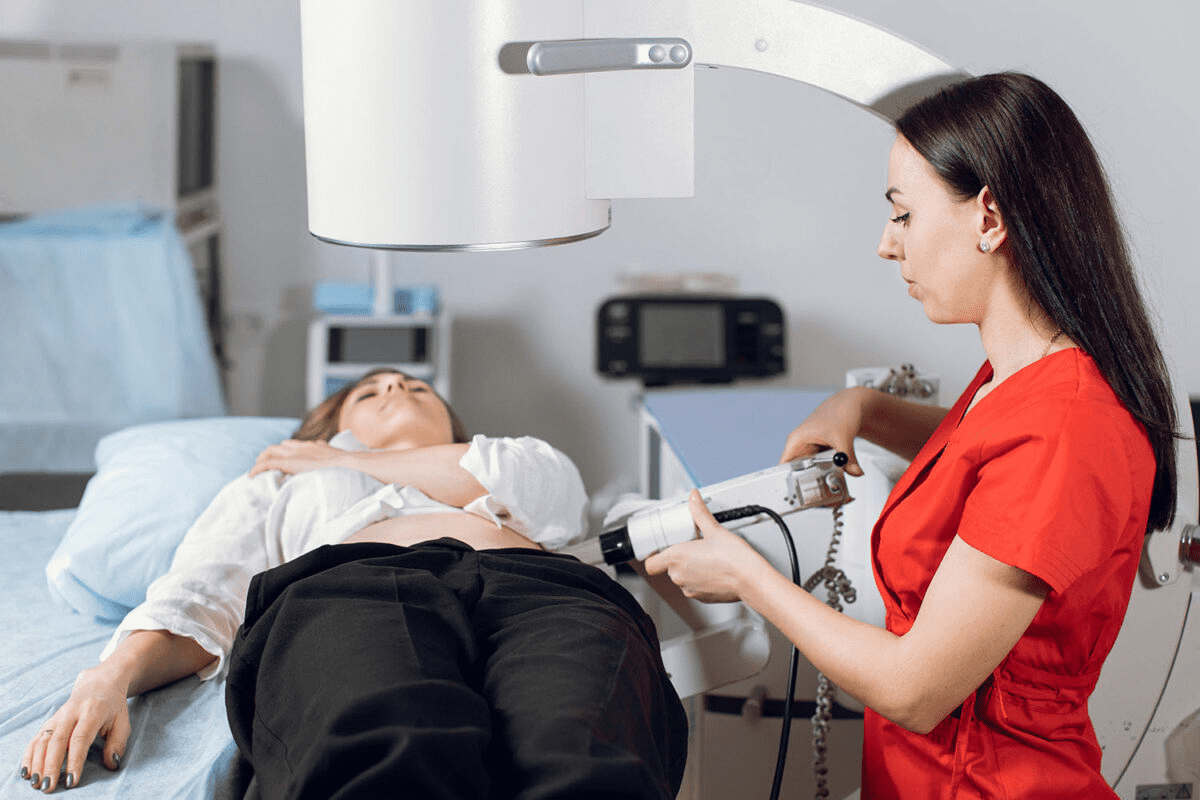Last Updated on November 27, 2025 by Bilal Hasdemir

We are on the cusp of understanding the complex relationship between radiation and living systems. Radiobiology, the study of radiation’s impact on biological systems, is key in today’s world. This is because medical imaging and other sources of radiation are becoming more common.
Recent studies have shown the risks of radiation exposure, mainly in children. For example, radiation from medical imaging may increase the risk of blood cancers. CT scans, in particular, use ionizing radiation that could lead to cancer.
As experts in radiobiology, we know how vital it is to grasp the effects of radiation on human health. In this article, we will dive into the essential facts radiobiologists need to know. We aim to shed light on the latest insights and advancements in the field.
Key Takeaways
- Radiobiology is key to understanding radiation’s impact on living systems.
- Radiation exposure can lead to health risks, including cancer.
- Medical imaging is a major source of radiation exposure.
- Understanding radiation’s effects on human health is vital for patient care.
- Advances in radiobiology are essential for improving health, safety, and innovation.
The Foundational Principles of Radiobiology

Radiobiology combines biology and physics to study how radiation affects living things. It’s an interdisciplinary field that looks at how ionizing radiation interacts with living organisms. This is based on foundational texts on the subject. We will dive into these principles, covering what radiobiology is and how it has evolved.
Definition and Scope of the Field
Radiobiology studies how ionizing radiation affects living beings. It looks at how radiation impacts cells, genes, and overall health. This field uses biology, physics, and medicine to understand radiation damage and how to treat it.
The Evolution of Radiobiological Understanding
Our knowledge of radiobiology has grown a lot, starting with Wilhelm Conrad Röntgen’s discovery of X-rays in 1895. At first, we focused on radiation’s immediate effects, like burns and acute radiation syndrome. Now, we also study long-term effects, like cancer and genetic changes.
As radiobiological research keeps advancing, we’re getting a clearer picture of how radiation works at the molecular, cellular, and organismal levels.
The Study of Radiation: An Interdisciplinary Science

Understanding how radiation affects living things needs a mix of biology and physics. This field, called radiobiology, helps us understand how radiation works with living tissues. It’s key for finding new treatments and keeping us safe from radiation.
Radiobiology is all about how radiation affects living systems. It looks at both the physical and biological sides of radiation. By combining biology and physics, scientists can see how radiation damages cells.
The Integration of Biology and Physics
Biology and physics are at the heart of radiobiology. Biology tells us about living cells, while physics explains radiation. Together, they help researchers understand how radiation affects life.
“The interaction between radiation and living matter is a complex process that involves both physical and biological factors.” – A leading radiobiologist
Key Disciplines Contributing to Modern Radiobiology
Many fields add to the study of radiobiology. These include:
- Radiation physics, which explains how radiation works with matter.
- Molecular biology, which uncovers how radiation damages cells.
- Biochemistry, which studies how radiation changes metabolism.
- Oncology, which uses radiobiology to fight cancer.
| Discipline | Contribution to Radiobiology |
| Radiation Physics | Understanding radiation types and interactions |
| Molecular Biology | Mechanisms of radiation damage at the cellular level |
| Biochemistry | Metabolic changes induced by radiation |
| Oncology | Application of radiobiological principles to cancer treatment |
By combining these fields, scientists can create better cancer treatments and ways to protect us from radiation. Studying radiation is more than just science. It’s about making our lives better and healthier.
Ionizing Radiation’s Mechanisms of Cellular Damage
Ionizing radiation can harm cells in many ways. It has enough energy to knock electrons out of atoms, making ions. This can damage living cells, leading to death or mutations.
Categories of Ionizing Radiation
Ionizing radiation falls into two main groups: particulate radiation and electromagnetic radiation. Particulate radiation includes alpha, beta particles, and neutrons. Electromagnetic radiation includes X-rays and gamma rays. Each type can damage cells differently.
- Alpha particles are high-energy helium nuclei that can be stopped by a sheet of paper but are highly ionizing.
- Beta particles are high-energy electrons that can travel several meters in air and require a few millimeters of metal to stop them.
- Gamma rays are high-energy electromagnetic waves that require thick, dense materials like lead to stop them.
Cellular Structures Vulnerable to Radiation
Cells have structures that radiation can harm. The most critical is DNA. Damage to DNA can cause mutations or cell death. Other structures, like proteins and cell membranes, can also be affected, disrupting cell function.
“Radiation damage to DNA is a major concern because it can lead to mutations that may cause cancer or cell death.”
” Radiobiology Expert
Dose-Response Relationships
The impact of ionizing radiation on cells is described by dose-response relationships. These relationships show how the dose of radiation affects biological effects. Understanding these is key for predicting risks and developing radiation therapies.
- The linear no-threshold (LNT) model is commonly used to estimate cancer risk from radiation exposure.
- Dose-response relationships can vary depending on the type of radiation and the biological endpoint being measured.
Knowing how ionizing radiation damages cells helps us understand its risks and benefits. This knowledge is vital for improving radiobiology and radiation medicine.
DNA as the Critical Target in Radiation Biology
In radiation biology, DNA is seen as the most important target. It’s key for cells to work right and stay alive. Damage to DNA can cause big problems.
Direct DNA Damage Pathways
Radiation can directly hit DNA, causing harm. This damage can happen in many ways, like breaking DNA strands. Double-strand breaks (DSBs) are very bad because they can mess up genes if not fixed right.
The kind of radiation and its energy level affect how it damages DNA. For example, alpha particles, with high energy, cause more damage than gamma rays.
Indirect Effects and Free Radical Formation
Radiation also causes indirect damage to DNA. It does this by making free radicals when it hits water in cells. These free radicals can damage DNA in many ways, like breaking strands or changing bases.
Cellular Repair Mechanisms and Their Limitations
Cells have ways to fix DNA damage. They use non-homologous end joining (NHEJ) and homologous recombination (HR) to fix DSBs. But, these methods can sometimes make mistakes, leading to mutations.
How well cells fix DNA damage depends on the cell type and its stage in the cell cycle. Genetic mutations can also play a role.
| Repair Mechanism | Description | Error Proneness |
| NHEJ | Directly seals DSBs without requiring a template | High |
| HR | Uses a template to repair DSBs accurately | Low |
Knowing how DNA gets damaged and fixed is key to improving radiation biology. It helps us find ways to lessen radiation’s harm.
The Latent Period: Time Between Exposure and Observable Effects
The latent period is key in radiation biology. It’s the time from when we’re exposed to radiation to when we see its effects. This time is important because it helps us understand and predict what happens after exposure.
Defining the Latency Phenomenon
The latency phenomenon in radiation biology is the wait between exposure and when effects start. This wait time can change a lot. It depends on the dose and type of radiation, and what biological effect we’re looking at.
Key aspects of the latency phenomenon include:
- The wait time can be anywhere from a few minutes to years or even decades.
- This wait time isn’t always the same; it changes with the dose and type of radiation.
- How long we wait can differ based on the biological system and effect we’re studying.
Factors Influencing Latency Duration
Several things can affect how long the wait is:
- Radiation Dose: A higher dose can make the wait shorter.
- Type of Radiation: Different kinds of radiation (like alpha, beta, gamma) can have different effects and change the wait time.
- Biological Endpoint: The wait time can also change based on the specific biological effect we’re looking at.
Knowing these factors helps us predict and manage the effects of radiation exposure.
Clinical Significance in Radiation Medicine
The latent period is very important in radiation medicine. It helps us understand and treat radiation injuries better. Knowing about the wait time lets doctors keep a closer eye on patients over time.
“The concept of latency is fundamental to understanding the long-term consequences of radiation exposure, guiding both treatment protocols and patient follow-up strategies.” –
A leading radiobiologist
By understanding the latent period and what affects it, we can handle radiation exposure better. This helps improve patient care and outcomes.
Biological Damage Caused by Gamma Rays in Living Systems
Gamma rays have a big impact on living things. They can cause damage and changes in cells. We will look at how gamma rays harm living systems.
Ionization Events and Their Cellular Consequences
Gamma rays create ionization events in living tissues. This leads to free radicals and damage to cells. We will see how gamma rays affect cells.
Exposure to gamma rays can lead to genetic mutations and cell death. It can also start cancer. Knowing this helps us understand the risks of gamma radiation.
Tissue-Specific Responses to Gamma Radiation
Different parts of the body react differently to gamma rays. This depends on how sensitive they are and the dose they get. We will talk about how different tissues respond.
Parts of the body that grow and replace cells fast, like bone marrow, are very sensitive. But, parts that grow slowly, like nerve tissue, are less sensitive.
Comparative Effects with Other Radiation Types
Gamma radiation is not the only kind of ionizing radiation. There are alpha particles and beta particles too. We will compare their effects on living tissues.
Each type of radiation has a different impact. Some are more harmful than others for the same dose. Knowing this helps us protect against radiation.
Linear Energy Transfer (LET): The Radiation Biologist’s Essential Metric
LET is key for checking how good radiation is and its effects on living tissues. As radiation biologists, we use LET to see how much energy is put into each path. This helps us understand how radiation affects living cells.
Quantifying Radiation Quality Through LET
LET shows how much energy radiation puts into a material or tissue as it moves through. It’s measured in kiloelectronvolts per micrometer (keV/μm). By knowing LET, we can see how much damage radiation can do to cells.
High LET radiation, like alpha particles, packs a lot of energy in a short distance. This causes a lot of damage to cells. On the other hand, low LET radiation, like X-rays or gamma rays, spreads out its energy more. This makes it less harmful.
High vs. Low LET Radiation Effects
Radiation’s effects on living things change a lot based on LET. High LET radiation, like alpha particles, can cause big DNA breaks. This leads to more serious damage.
| Radiation Type | LET Value (keV/μm) | Biological Effect |
| Alpha Particles | High (50-230) | Significant DNA damage, high risk of cell death |
| Gamma Rays | Low (0.2-2) | Less DNA damage, lower risk of cell death |
Applications in Treatment Planning
Knowing LET is key for planning radiation therapy. By looking at LET, doctors can make treatment plans better. This helps kill tumors while protecting healthy tissues.
For example, proton therapy has a higher LET than usual photon therapy. This lets doctors give more dose to tumors while keeping healthy tissues safe. So, LET is very important for making good radiation treatment plans.
Spatial Distribution Concepts in Radiation Biology
The way radiation spreads through tissues affects its biological impact. Knowing this spread is key for diagnosing and treating radiation-related conditions.
Understanding Radiation Distribution in Tissues
Radiation doesn’t spread evenly in tissues. Its distribution changes based on the radiation type and energy. High-energy radiation goes deeper, while lower energy stays closer to the surface.
Studying how radiation spreads helps us understand its effects on living things. We look at the radiation’s physical traits and the tissues’ biological makeup.
Micro-dosimetry and Its Clinical Relevance
Micro-dosimetry studies radiation dose at the microscopic level. It’s key for understanding radiation’s effects on small targets like cells.
In radiation therapy, it helps measure doses to tumors and healthy tissues. This improves treatment results.
“The precise measurement of radiation dose at the cellular level is essential for understanding radiation-induced biological effects.”
Imaging Technologies in Spatial Assessment
Imaging technologies are vital for seeing how radiation spreads in tissues. Tools like PET and SPECT scans show where radioactive tracers are in the body.
| Imaging Technology | Application in Radiation Biology |
| PET Scan | Assesses metabolic activity and radiation distribution |
| SPECT Scan | Provides detailed images of radiation distribution |
Therapeutic Applications and Patient Care in Radiologic Sciences
Therapeutic applications in radiologic sciences have changed patient care for the better. They bring new hope and better results. It’s important to focus on both the benefits and safety in patient care.
Radiation Protection Principles
Radiation protection is key in radiologic sciences. It keeps patients and healthcare workers safe from radiation harm. We aim to keep doses As Low As Reasonably Achievable (ALARA). This balance ensures safety and effectiveness.
Several strategies are used for radiation protection:
- Using alternative imaging when possible
- Optimizing equipment settings to lower dose
- Employing shielding and protective gear
- Monitoring radiation exposure levels
Emerging Technologies in Radiation Medicine
The field of radiation medicine is on the verge of a big change. Emerging technologies will improve treatment precision and patient results. New tools like proton therapy, advanced imaging, and personalized medicine are leading this change.
Proton therapy is a big step forward. It targets tumors more accurately, reducing harm to healthy tissue. Also, artificial intelligence and machine learning are being used in treatment planning. They make treatments more accurate and efficient.
Long-Term Consequences of Radiation Exposure
Radiation exposure can deeply affect the human body over time. We see that its impact goes beyond immediate damage. We will look into how radiation causes cancer, organ problems, and how we assess risks.
Mechanisms of Radiation-Induced Carcinogenesis
Radiation can damage DNA and disrupt cell repair. This can lead to genetic mutations. If these mutations are not fixed, they can cause cancer. The risk of radiation-induced cancer is a major concern for individuals exposed to high levels of radiation.
Research shows radiation can cause different cancers, like leukemia and solid tumors. The time it takes for cancer to develop after exposure can be years or decades. This makes long-term monitoring of exposed people very important.
“The risk of cancer from radiation exposure is a significant concern, and understanding the mechanisms behind radiation-induced carcinogenesis is essential for developing effective risk assessment models.”
Organ-Specific Dysfunction
Organs react differently to radiation, leading to specific problems. For example, the bone marrow is very sensitive and can fail with radiation exposure. Other organs, like the lungs and liver, can also be affected by the dose and type of radiation.
The severity of organ dysfunction depends on several factors, including the dose, dose rate, and radiation quality. Knowing these factors helps predict and lessen long-term effects.
Risk Assessment and Predictive Models
Risk assessment models are key to understanding radiation’s long-term effects. They help forecast health risks like cancer and organ problems. By studying data from various sources, scientists can make these models more accurate.
- Risk assessment models consider factors such as radiation dose, dose rate, and radiation type.
- These models are essential for setting safety standards and guidelines for radiation exposure.
- Continuous refinement of these models is necessary to incorporate new research findings and improve predictive accuracy.
As we learn more about radiation biology, we can improve risk assessment models. This will help guide people exposed to radiation better.
Conclusion: Advancing the Future of Radiobiology
As we wrap up our look into the study of radiation, it’s clear that radiobiology is key. It keeps growing as new findings and breakthroughs help us grasp how radiation affects us. This field is vital for understanding health impacts.
Through radiobiology, we learn about how radiation damages cells and DNA. We also understand how to fix these damages. This knowledge helps in making medicine better and keeping people safe from radiation.
Looking ahead, we must keep pushing the boundaries of radiobiology. This will help us give better care to patients and find new ways to treat diseases. The future of radiobiology is bright, and we’re all in for the journey.
FAQ
What is radiobiology, and why is it important?
Radiobiology studies how radiation affects living things. It helps us understand how radiation impacts health. It also aids in finding treatments for diseases caused by radiation.
What is the definition of radiation biology?
Radiation biology, or radiobiology, looks at how radiation affects living things. This includes both ionizing and non-ionizing types.
What are the categories of ionizing radiation?
Ionizing radiation includes alpha, beta, gamma, and X-rays. Each type has its own effects on living systems.
What is the role of DNA in radiation biology?
DNA is key in radiation biology. Damage to DNA can cause mutations, chromosomal problems, and cell death.
What is the latent period in radiation biology?
The latent period is the time after radiation exposure before effects are seen. It varies based on dose, radiation type, and individual factors.
What is the significance of Linear Energy Transfer (LET) in radiation biology?
LET measures energy deposited by radiation per unit path length. It helps predict the biological effects of different radiation types.
How do gamma rays cause biological damage in living systems?
Gamma rays damage living systems through ionization. This leads to DNA damage, oxidative stress, and other cellular issues.
What is micro-dosimetry, and how is it used in radiation biology?
Micro-dosimetry studies radiation energy at the microscopic level. It’s vital for understanding radiation effects on tissues and cells.
What are the long-term consequences of radiation exposure?
Radiation exposure can lead to cancer, organ problems, and genetic mutations. Risk models help predict these effects.
How is radiation protection applied in radiologic sciences?
Radiation protection uses principles to reduce exposure. Techniques include shielding, distance, and time to protect patients, staff, and the public.
What are the emerging technologies in radiation medicine?
New technologies in radiation medicine include advanced imaging and MRI-guided therapy. These improve treatment results and patient care.
Reference
National Center for Biotechnology Information on Ionizing Radiation Biological Effects. https://www.ncbi.nlm.nih.gov/books/NBK232919






